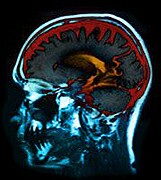
WEDNESDAY, June 22 (HealthDay News) — Researchers searching for an early indicator of autism say they’ve discovered a promising possibility: an impairment in the ability of the brain’s right and left hemispheres to communicate with each other.
In the study, researchers did brain imaging scans (fMRIs) on 29 sleeping toddlers with autism, 30 typically developing kids and 13 children with significant language delays, but not autism. All were between 1 and 4 years old.
The scans showed that the language areas of the left and right hemispheres of the autistic toddlers’ brains were less “in sync” than the hemispheres of the typical kids and the children with other language delays.
The weaker the synchronization, the more severe the autistic child’s communication difficulties.
“No one really knows why synchronization is important, but it’s clearly a robust phenomenon apparent in the brains of animals and humans of all ages,” said lead study author Ilan Dinstein, a neurobiologist at the Weizmann Institute of Science in Rehovot, Israel, and a member of the Autism Center of Excellence at the University of California, San Diego.
“The main theory is that it is important for the proper communication between different brain areas,” Dinstein added. “Such communication is thought to be essential for normal brain function and for normal behavior.”
The study is published in the June 23 issue of the journal Neuron.
Neural synchronization refers to the coordinated timing of neural activity across distinct brain areas, Dinstein explained. In a normal brain, neurons in separate areas belonging to a system with a particular function, such as vision or language, always stay in sync, even during sleep.
“The brain is always active, even when you’re sleeping. So you can assess synchronization both during wake and sleep,” Dinstein said.
Think of it like a series of lightbulbs on the same circuit, explained Dr. Gary Goldstein, president and chief executive officer of the Kennedy Krieger Institute in Baltimore, who was not involved in the research.
In the brains of normally developing children and kids with language difficulties, the lightbulbs on the circuits oscillate, that is, all get brighter or dimmer in the right and left hemispheres at the same time. In the kids with autism, the hemispheres are out of sync. The circuits on the left side get brighter as those on the right side get dimmer.
Specifically, researchers found communication differences in the left and right inferior frontal gyrus, which is involved with speech, and the superior temporal gyrus, which is involved in receptive language, or understanding what people say, Goldstein said.
Researchers said the findings could help in the search for methods to screen for autism even before obvious symptoms emerge.
“The idea is that our measure would be one of several measures developed over the next few years, which together would give good accuracy in identifying autism in extremely young toddlers,” Dinstein said. “Having biological measures for diagnosing autism would revolutionize the field.”
Goldstein said it was unlikely fMRIs would be used to diagnosis autism. Most hospitals don’t have the equipment. It’s expensive, time consuming, and interpreting the images requires extensive training, he said.
Even so, the study is intriguing in that it fits with genetic research that’s identified more than 20 autism risk genes. “Those genes, by and large, code for proteins that make the synapses work, or the connections between neurons,” Goldstein said. “These researchers are looking at the next step up, which are the circuits, or the connections between the brain regions.”
It would be interesting to study whether learning and behavioral therapy can change those patterns, he added.
Geraldine Dawson, chief science officer of Autism Speaks, said the study adds to the evidence that autism may be, at least in part, a “developmental disconnection syndrome.” Prior research has also found connectivity problems between different brain regions in autism.
“This helps explain why people with autism have trouble with complex behaviors, such as social interaction and language, which require coordinated activity across several brain regions,” Dawson said. “This study suggests that faulty neural connectivity is an early characteristic of autism and helps explain some of the symptoms that emerge in the first couple of years of life. Even early gestures and social games require coordinated activity among several brain regions.”
More information
The U.S. National Institute of Neurological Disorders and Stroke has more on autism.

